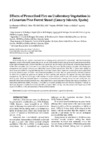Please use this identifier to cite or link to this item:
https://accedacris.ulpgc.es/jspui/handle/10553/106444
| Title: | Effects of Prescribed Fire on Understory Vegetation in a Canarian Pine Forest Stand (Canary Islands, Spain) | Authors: | Árevalo Sierra,José Ramón Fernández-Lugo, Silvia Afonso, Virginia Grillo Delgado, Federico Naranjo Cigala, Agustín |
UNESCO Clasification: | 2417 Biología vegetal (botánica) | Keywords: | Fire Fuel-load management Pine forest Reforestation Vegetation dynamics |
Issue Date: | 2014 | Journal: | Bulletin Of University Of Agricultural Sciences And Veterinary Medicine Cluj-Napoca-Food Science And Technology | Abstract: | Historically, fire has played a dominant role in shaping many forest plant communities. Mediterranean-type vegetation is one of the world’s major fire-prone biomes, with conifer forests among the most flammable ecosystems in the Mediterranean region. Prescribed fires are a powerful tool for reducing fire hazards by decreasing amounts of fuel. The main objective of this work is to analyse the effects of prescribed burning on the understory vegetation composition and species richness in a reforested stand of Pinus canariensis. Nine 900 m2 plots were settled in areas were prescribed burning had been applied in the last 5 years; their respective control plots were established in nearby unburnt areas of similar environmental conditions. In each plot, we systematically selected 10 points in which we sampled the presence of species in 1m2 quadrats and analysed for species richness and species composition. No significant changes in the number of species richness were found medium term after prescribed burning. Also, when we analysed species composition, no discrimination among the control and burnt plots was detected. From an ecological point of view, prescribed fire is a good practice to reduce biomass accumulation in P. canariensis reforested stands, resulting in low effects in species composition and richness. However, it would be necessary long-term studies to evaluate the effects of prescribed burning intensity, season and frequency, as well as positive effects on the naturalization of these artificial stands. | URI: | https://accedacris.ulpgc.es/handle/10553/106444 | ISSN: | 1843-5386 | DOI: | 10.15835/buasvmcn-agr: 10849 | Source: | Bulletin Of University Of Agricultural Sciences And Veterinary Medicine Cluj-Napoca. Agriculture [1843-5386], vol.17, no 2 (2014), p. 133-137 |
| Appears in Collections: | Artículos |
Items in accedaCRIS are protected by copyright, with all rights reserved, unless otherwise indicated.
